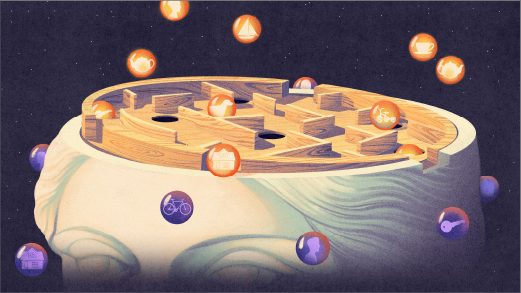What was going on? The rodents’ waking brains had generated electrical activity that oscillated at a constant rate. When they were anesthetized, however, their brains seemed to irregularly fire off much faster patterns.
Other researchers had observed the fast waves too. Buzsáki’s postdoctoral adviser Cornelius Vanderwolf had described the irregular patterns in 1969, and the Nobel Prize-winning neuroscientist John O’Keefe coined the term “ripples” to describe them in the 1970s. But it wasn’t until Buzsáki heard them for himself that he became obsessed.
He spent much of his lab time over the next decade trying to characterize these electrical bursts. In the late 1980s, researchers discovered that they could induce neurons to make stronger interconnections, linked to learning and memory, by artificially stimulating them to fire in rapid bursts. To Buzsáki, those bursts sounded a lot like his waves. In 1989, he first hypothesized that sharp wave ripples might be part of the brain’s mechanism for forming and consolidating memories.
“He had the idea that this was not some noisy activity, but it was relevant for the brain,” said Michaël Zugaro, a neuroscientist at the Collège de France who worked as a postdoc in Buzsáki’s lab in 2002. “That was a great anticipation of future discoveries because at the time very little was actually known.”
In the 1990s and early 2000s, researchers took advantage of improved computing power and new tools that could record electrical activity from over 100 neurons at once to better characterize sharp wave ripples. Buzsáki and other scientists discovered that the ripples seemed to replay brain activity from an animal’s experience, such as running through a maze — except that the replay ripples oscillated 10 to 20 times faster than the original signals. One 2002 paper, which “made sharp wave ripples very famous,” said Hiroaki Norimoto, a professor of neuroscience at Nagoya University in Japan, found that the ripples occurred not only during sleep, but also while the animals were awake and resting.
In 2009 and 2010, two papers, including one led by Zugaro, showed that sharp wave ripples were involved in consolidating memories to endure over the long term. When researchers suppressed or disrupted the ripples, rats performed worse on memory tasks. “When you destroy them, then the animal no longer remembers,” Zugaro said. Later studies showed that elongating or creating more ripples improved rats’ memory.
It became clear that the ripples were playing repeatedly to cement a memory. “The brain is rehearsing,” said Lila Davachi, a professor of psychology at Columbia University. “Even in these moments of wakeful rest, your brain continues to rehearse and replay the past.”
Imagine an experience as “a melody on the piano,” said Daniel Bendor, a neuroscientist at University College London. A specific sequence of neurons fires to record an experience, just as a pianist taps out a specific sequence of keys. Then, during sleep, the hippocampus replays that sequence — but faster and potentially hundreds or thousands of times. The frenetic sharp wave ripples propagate out from the hippocampus, a way station in the brain for “episodic memories” of particular experiences, toward the cortex, which is involved in long-term memory storage.
However, no one could explain why the ripples propagated while an animal was awake and resting. “[They] must serve some other purpose,” Bendor recalled thinking. Scientists had many ideas. Some proposed that waking ripples helped with planning or decision-making. Others suggested that they modified or reallocated memories in some way.
Another idea, which several groups proposed, was that replay while an animal was awake and replay during sleep were intimately tied — and that they could be the mechanism by which the brain chooses what experiences to remember.
Memory Trials
At NYU, boxes of resting and sleeping mice sat in an infrared-lit room. In the room next door were handcrafted mazes, constructed from plastic and tape. One at a time, the mice were placed in the mazes. They ran around, wearing electrodes that recorded the activity of around 500 hippocampal neurons, and learned that certain routes would earn them a reward of water. As they explored the maze, the mice took small breaks to rest or groom themselves. And after their trials were over, they were returned to their home cage for a snooze. The researchers continued to record their brain activity as they slept.
Yang analyzed the data by mapping which neurons fired during different trials. She saw a lot of variation — some neurons fired during early trials, and others fired during later ones. Sometimes they fired at different rates. That told her that the brain recorded an animal’s experience of individual trials differently. Notably, some trials were followed by bursts of sharp wave ripples, while others weren’t.
>>> Read full article>>>
Copyright for syndicated content belongs to the linked Source : Quanta Magazine – https://www.quantamagazine.org/electric-ripples-in-the-resting-brain-tag-memories-for-storage-20240521/
